Reconstruction of Galaxy Clusters by Gravitational Lensing
General considerations
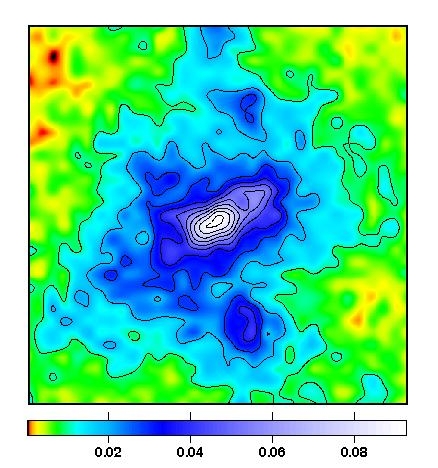 The content of our work is the precise reconstruction of the mass
profile of a galaxy cluster. As mentioned in
the general introduction, galaxy clusters are very important
cosmological objects whose abundance in the sky and exact mass has
to be determined accurately. In our opinion gravitational lensing is
the most promising method for this task.
The content of our work is the precise reconstruction of the mass
profile of a galaxy cluster. As mentioned in
the general introduction, galaxy clusters are very important
cosmological objects whose abundance in the sky and exact mass has
to be determined accurately. In our opinion gravitational lensing is
the most promising method for this task.While strong lensing allows for an highly resolved reconstruction of the cluster core, weak lensing constrains the whole observed field. A combination of both effects, like we suggest in our method, offers the possibility to reconstruct a galaxy cluster on all observed scales.
References
Besides our own publications, also two other methods combining weak and strong lensing are listed here.- Combining weak and strong lensing in cluster potential reconstruction
Cacciato, Bartelmann, Meneghetti, Moscardini
2006, A&A, 458, 349
[astro-ph] - Combining weak and strong cluster lensing: Applications to
simulations and MS 2137
Merten, Cacciato, Meneghetti, Mignone, Bartelmann
2008, submitted to A&A
[astro-ph] - Strong and weak lensing united I: the combined strong and weak
lensing cluster mass reconstruction method
Bradač, Schneider, Lombardi, Erben
2005, A&A, 437, 39
[astro-ph] - Combined reconstruction of weak and strong lensing data with
WSLAP
Diego, Tegmark, Protopapas, Sandvik
2007, MNRAS, 375, 958
[astro-ph]
The reconstruction method
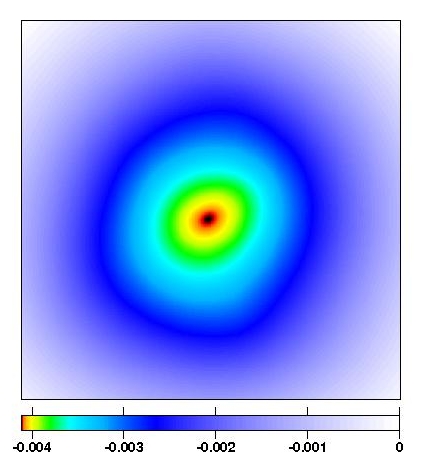 We decided to focus on the lensing potential as reconstruction
quantity. It is the rescaled and line-of-sight integrated Newtonian
Potential. The main advantage of this potential compared to other more
direct reconstruction quantities like e.g. the density distribution
is its smoothness, which makes it very stable against noise and
outliers in the input data.
We decided to focus on the lensing potential as reconstruction
quantity. It is the rescaled and line-of-sight integrated Newtonian
Potential. The main advantage of this potential compared to other more
direct reconstruction quantities like e.g. the density distribution
is its smoothness, which makes it very stable against noise and
outliers in the input data.The basic idea of our algorithm is a so-called maximum-likelihood method, which tries to find the lensing potential that is most likely to have caused the observed effects. To do so, we divide the observed field into pixels and obtain a regular grid. Afterwards, we define a chi-square-function in every pixel and minimise it on that grid. The quantity with respect to which we minimise is the lensing potential itself. While doing so and additionally assigning to every pixel an observational constraint which depends on the lensing potential, we obtain a non-parametric reconstruction method. How this chi-square-function looks explicitly, we explain in the next section.
References
Here a reference to maximum-likelihood based cluster-reconstruction methods.- Maximum-likelihood Cluster Reconstruction
Bartelmann, Narayan, Seitz, Schneider
1996, ApJ, 464L, 115B
[astro-ph]
Different lensing effects
At this development stage of our algorithm, we use two different lensing constraints in our reconstructions.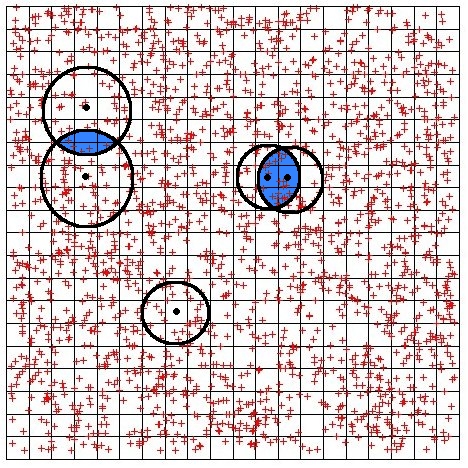 First, there is weak
lensing, meaning slight elliptical distortions of the background
galaxies. Like described in the article about lensing this effect has to be treated
statistically, since the background galaxies also carry intrinsic
ellipticity. One can show that the expectation value of the
ellipticity is equal to a characteristic lens quantity called reduced
shear, which is dependent on second derivatives of the lensing
potential. In this way we found the quantity to define the weak-lensing
chi-square function. To perform the necessary average over background
galaxies, circles around each pixel are drawn, whose radii
iteratively increase until a sufficient number of galaxies (usually 10-15) is
contained. The radii of different pixels can overlap, the emerging
correlations are taken into account during the reconstruction.
First, there is weak
lensing, meaning slight elliptical distortions of the background
galaxies. Like described in the article about lensing this effect has to be treated
statistically, since the background galaxies also carry intrinsic
ellipticity. One can show that the expectation value of the
ellipticity is equal to a characteristic lens quantity called reduced
shear, which is dependent on second derivatives of the lensing
potential. In this way we found the quantity to define the weak-lensing
chi-square function. To perform the necessary average over background
galaxies, circles around each pixel are drawn, whose radii
iteratively increase until a sufficient number of galaxies (usually 10-15) is
contained. The radii of different pixels can overlap, the emerging
correlations are taken into account during the reconstruction.The constraint corresponding to strong lensing are gravitational arcs. Given the resolution is not too high, one can show that these arcs lie closely to the so-called critical curve of the lens. This is another characteristic lensing quantity which also depends on second derivatives of the lensing potential. For every pixel containing parts of an arc, we define an additional chi-square function which takes into account the strong lensing effect. Because these arcs are observable very well and the grid resolution due to the weak-lensing averaging is low anyway, we use a refined grid resolution for these pixels in order to conserve the strong lensing information.
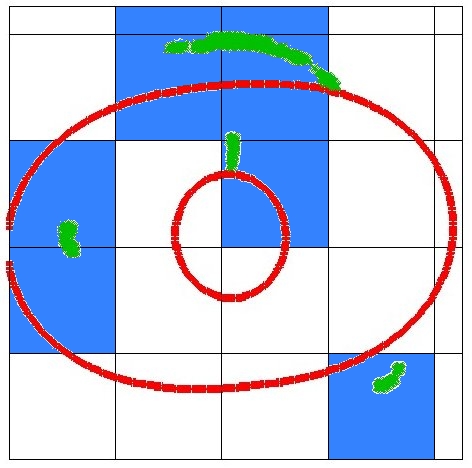
References
A detailed description of the method, including the missing formulas, can be found here.- Combining weak and strong cluster lensing: Applications to
simulations and MS 2137
Merten, Cacciato, Meneghetti, Mignone, Bartelmann
2008, submitted to A&A
[astro-ph]
Advantages of our method
Before we focus on more technical details, we want to point out the main advantages of our method, compared to other concepts.- The advantage over methods which are limited to only one lensing effect is obvious. A combination of both effects allows a reliable reconstruction on all scales.
- The maximum-likelihood approach makes the method enormously flexible since one can define chi-square functions for many different observations. In fact, right now we are including flexion and multiple image systems.
- The adaptive-averaging scheme for the background galaxies allows for reconstructions on high resolution even with a low density of background galaxies.
- The usage of arcs as strong lensing constraint is very convenient since they are much easier to observe than e.g. multiple image systems.
Numerical implementation
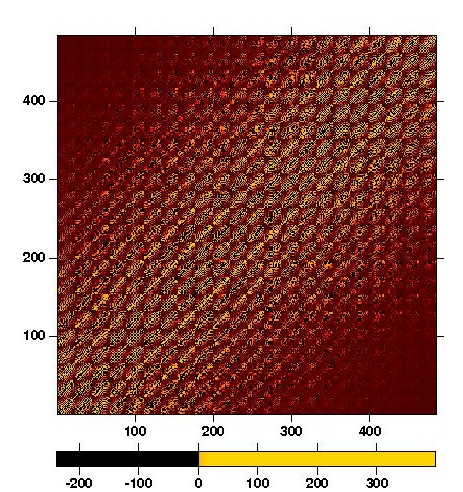 The concrete technical and numerical implementation of the
reconstruction method described above is not an easy task. First of
all, mostly second derivatives of the lensing potential are appearing
in the chi-square function. We represent those by finite differences
on the grid, which allows to perform the derivatives by simple matrix
multiplications. The problem is that many of these multiplications
with a high dimensionality are necessary. Fortunately, those matrices
are relatively sparse band matrices, which allow for specialised and
extremely fast multiplication algorithms. In practise we achieved an
increase in speed by a factor of 1000 while using these
algorithms. Another issue is the inversion of also high-dimensional
covariance matrices. For this purpose, we use already available and
reliable routines for matrix inversion.
The concrete technical and numerical implementation of the
reconstruction method described above is not an easy task. First of
all, mostly second derivatives of the lensing potential are appearing
in the chi-square function. We represent those by finite differences
on the grid, which allows to perform the derivatives by simple matrix
multiplications. The problem is that many of these multiplications
with a high dimensionality are necessary. Fortunately, those matrices
are relatively sparse band matrices, which allow for specialised and
extremely fast multiplication algorithms. In practise we achieved an
increase in speed by a factor of 1000 while using these
algorithms. Another issue is the inversion of also high-dimensional
covariance matrices. For this purpose, we use already available and
reliable routines for matrix inversion.Furthermore, we use a complicated two-level iteration scheme, which sums up to a maximum of 200 iterations per reconstruction. This means a high amount of CPU-time, which convinced us to parallelise the code. Right now it is optimised to run on machines with 10-25 cores.
Some additional words on the concrete appearance of the package. The is code object-oriented and written in C++. All fundamental functions can be called independently from the reconstruction routine and are available in the code libraries. To provide basic usability, it can be configured and run by configuration files. For an easy installation there is a Makefile available.
In the end a listing of external libraries used, besides the C standard library, and their function in the code.
-
GNU Scientific Library
(GSL)
vector/matrix handling, statistics, complex numbers, linear systems of equations, random numbers. -
Numerical Recipes (NR)
two-dimensional bicubic spline interpolation (might be replaced by GSL in the future). -
Linear Algebra Package
(LAPACK)
high-dimensional matrix inversion, linear systems of equations. -
CFITSIO &
CCfits
in. -and output in FITS-format. -
Message Passing Interface
(MPI)
parallelising to many processes.
The code is available in our Repository.
Responsible: Simon Glover, last modification Nov/04/2008 08:41 CET

 CV
CV